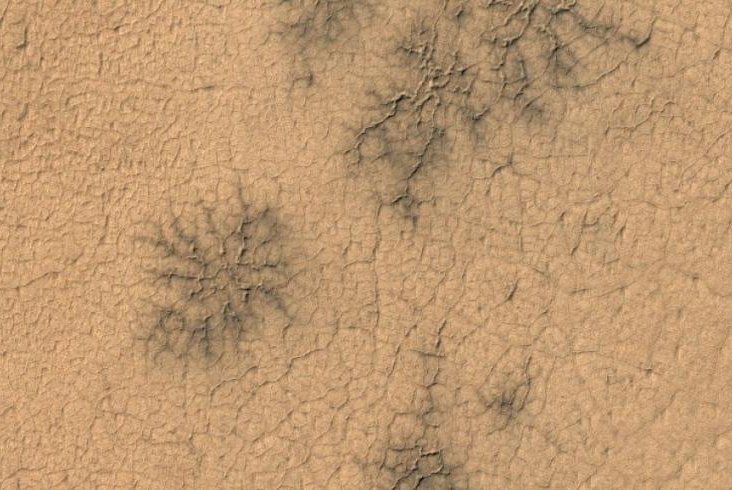Citizen scientists helped researchers locate geologic formations called 'spiders' in unexpected locations on Mars' surface. Photo by University of Oxford
Aug. 30 (UPI) -- Bowie wasn't lying about Ziggy's bandmates -- there are spiders from Mars. Sort of.
These 'spiders' aren't eight-legged arachnids. They're unique geologic formations. And it turns out, the spider web-like networks of cracks on Mars surface are more ubiquitous than scientists thought.
A group of citizen scientists have identified several spiders on Mars in regions where researchers didn't expect the formations to be present.
Researchers believe the formations, called araneiforms, are created when carbon dioxide-turned-ice is heated by sunlight as winter turns to spring and gas beneath races to escape the icy layer above. As the gas rushes to escape, it erodes the Red Planet's surface, leaving behind spindly, spider leg-like streaks.
Until now, planetary scientists believed araneiforms were only found among South Polar Layered Deposits, or SPLDs, flat layers of water ice and dust.
Thousands of volunteers at the citizen science platform Zooniverse have helped researchers scan more than 20,000 images captured by the Mars Reconnaissance Orbiter's Context Camera in search of spiders. Several spiders have been identified in areas outside SPLDs. The discoveries have been confirmed by the orbiter's High Resolution Imaging Experiment camera.
"This was a totally unexpected find," Meg Schwamb, a researcher at the Gemini Observatory, said in a news release. "By having so many eyes scouring the images, we know now that the SPLD is not the only place where spiders form. This will help us better understand the carbon dioxide jet formation process."
Spiders and their formation process are incredibly unique. Earth is without a similar phenomenon. Only Neptune's moon Triton features a similar geologic formation. Thus, the phenomenon offers a window through which to view the uniqueness of the Red Planet's geology and atmosphere.
"The jet process is linked to the Martian seasons and is returning carbon dioxide to the atmosphere, studying these new locales will give new insights into the Martian atmosphere," Schwamb said.
Researchers described their discovery of unusual spider locales in the journal Icarus.















